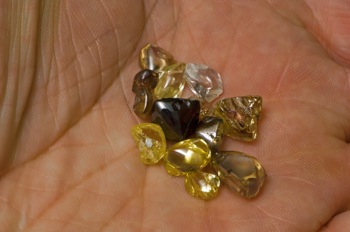
Courtesy Arkansas Dept. of Tourism
Visitors to the Kansas Underground Salt Mine near Hutchinson are often surprised at how spacious the mine area is, even though it is several hundred feet beneath the surface of the earth.
“People are really surprised at how vast and wide open the spaces are,” said Gayle Ferrell, director of operations. “They assume they are going into a cave, a dark, enclosed place, but it is very wide open, stable and safe.”
Dark, enclosed spaces are what visitors to the Buckley Coal Mine Museum in Buckley, W.Va., encounter as they learn about the arduous and often dangerous process of extracting coal from low-seam mines a century ago.
Meanwhile, the view from the Bingham Canyon Mine Visitors Center in Utah sweeps across a mammoth open-pit copper mine that is so large it can be seen from space.
And then there is the Crater of Diamonds State Park near Murfreesboro, Ark., where lucky visitors might find precious gems by just strolling through the park.
Valuable minerals are extracted from the earth in a variety of ways, and attractions around the country provide a window into the mining industry.
Sixteen tons of black gold
Although coal mining is still a major industry in the United States, Renda Morris, a coal miner’s daughter, wants to preserve the industry’s heritage.
“So much of the history, posterity, is just fading away,” said Morris, executive director of the Beckley Coal Mine Museum. “I want to keep that alive.”
The Beckley complex preserves the history of coal mining at the beginning of the 20th century with a restored company town, 45-minute tours of a former coal mine and a museum in a former company store.
Visitors ride in mantrips, low-slung cars pulled by an engine that take miners into a mine.
“The tours are guided by experienced coal miners,” said Morris. “There is about 900 feet of track underground.”
Exhibits in the 14,000-square-foot Rahall Company Store include mining artifacts and tools, geological specimens and photographs of life in former coal company towns.
Authentically restored buildings in a re-created company town include a superintendent’s house, a three-room miner’s house, a church and a school.
www.beckleymine.com
304-256-1747
Salt of the earth
“We tell the story of salt mining, how mining was done in the past and currently is being done,” said Ferrell of the Kansas Underground Salt Mine.
A visit begins with a tour of the museum’s aboveground gallery, which contains exhibits and artifacts about salt mining, the geology of the area and how salt beds are formed.
There is also a popular exhibit area about another business at the mine — Underground Vaults and Storage — which stores a variety of documents and items, including Hollywood films and costumes, in the naturally climate-controlled underground spaces.
“We have some movie costumes on display from Sony and Warner Brothers,” said Ferrell. “They are a huge draw; they are the actual ones used.”
Current costumes on display include some from “Men in Black,” “Troy,” “Superman” and “Matrix” and the Batman costume worn by George Clooney.
Then it’s onto a hoist that carries you 650 feet down in less than two minutes. The tour, which lasts from 90 minutes to two hours, takes visitors into undeveloped areas of the still active mine, where they learn more about salt mining, see exhibits of mining equipment and get a souvenir piece of salt.
“What makes us unique is we are the only active salt mine that allows the general public to visit,” said Farrell.
Although the mine has been in operation since 1923, the tours are relatively new, having started in 2007.
www.undergroundmuseum.org
620-662-1425
Diamonds in the rough
Another one-of-a-kind mining attraction is the Crater of Diamonds State Park, the only diamond-producing site in the world open to the public.
Although the site is not a commercial operation, visitors can keep any diamonds or semiprecious stones they find. However, the fun is usually in the hunt, as only about two small diamonds a day, on average, are found at the site.
“We have screens, shovels and knee pads; we even rent wheelbarrows,” said Joan Ellison, public information officer for the Arkansas Department of Parks and Tourism.
The first stop is the Diamond Discovery Center. “There are exhibits about how to recognize diamonds in the rough and how to dig for them,” said Ellison. “It is all about teaching you about diamonds and how to find them.”
Helpful staff members will also give pointers and will identify, weigh and certify any diamonds that are found.
There are three main methods of searching for diamonds: digging and screening soil, washing the soil in a series of screens, or just walking up and down the rows of dirt looking for shiny objects.
The diamonds and other stones are located in a 37.5-acre plowed field that is the eroding surface of a volcanic pipe.
Ellison said if groups are pressed for time, they can view the center’s exhibits, see the orientation video, look out the windows at the diamond fields and visit with the diamond hunters, who are there on a regular basis and are very willing to share their experiences with visitors.
“The regulars are part of the park experience,” said Ellison.
And you might get lucky and hear the whistle that is blown whenever a diamond is found. After all, the largest North American diamond — 40.23 carats — was found at the park.
www.craterofdiamondsstatepark.com
870-285-3113
Seen from space
Kennecott Copper’s huge Bingham Canyon open-pit mine is nearly three miles across at the top and three-fourths of a mile deep — large enough that space shuttle astronauts can see it.
More than 18.5 million tons of copper has been mined from the site over more than a century, the most produced by any copper mine in history. Although the mine was originally scheduled to close in 2021, Kennecott is seeking permission to expand the mine and keep it in business for an additional 13 years.
The mine’s visitors center not only has interesting videos and interactive displays, such as 3-D microscopes to examine rock and mineral examples, it also provides great views of the mine operation.
“It’s tucked into a mine wall, right there in the action,” said spokesman Brian Davis. “It’s a stone’s throw away; you can look down into the mine.”
You can watch giant electric shovels scoop up 98 tons of rock at a time and dump it into 23-foot-tall trucks that can carry from 255 to 360 tons at a time and watch the trucks travel the approximately 500 miles of road inside the mine to take the rock to a crusher, which grinds it into chucks smaller than a basketball.
Also on display are old mining artifacts and three-dimensional models that help explain the mining operation, and a 16-minute video tells about the company’s history, present-day operations and future.
www.kennecott.com/visitors-center
801-204-2005
Golden opportunities
Dramatically different methods of searching for gold are on display in South Dakota, Georgia and California.
The Homestake Gold Mine in Lead, S.D., near Deadwood, is a large former open-cut mine that is a mile and a half wide and more than 1,250 feet deep.
Tours of the operation begin with a trolley tour through the historic town of Lead. Guides tell about the mining process, which includes the hoisting, crushing and milling of rock.
“We go into the hoist room, the room where all the drums and cables are that operate cars that go into and out of the mine,” said a spokesman for the company.
The one-hour tour takes visitors to the company’s state-of-the-art wastewater treatment plant and then to view the open-pit mine.
Visitors are given a sample of ore that was drilled from the gold mine at the end of the tour.
In Dahlonega, Ga., 40-minuted guided tours of the underground Consolidated Gold Mine discuss 19th-century mining techniques at the mine, which has been closed since 1907.
That is followed by an opportunity to do gold mining the old-fashioned way, by panning. Groups have an option of three packages. They can do just the underground tour, or they can do panning for gold or mining for gemstones or both.
The Gold Museum in the former 19th-century courthouse in Dahlonega tells about America’s first major gold rush in 1838 to the north Georgia mountains.
“It was hot and heavy here until the gold rush to California in 1849,” said a ranger at the state-run museum.
The exhibits include examples of Georgia gold in rough form and information about various forms of mining technology. There are also exhibits about the U.S. mint in Dahlonega, which minted more than 1 million coins from 1838 to 1861.
Sutter Gold Mine near Sutter Creek, Calif., is a modern hard-rock mine near several of the state’s historic mines. Originally opened in the late 1880s, the mine is now open exclusively for one-hour underground tours.
The tours provide a look at gold mining and its progression from gold panning and hydraulic mining to hard-rock techniques.
Above ground, visitors get to mine for gems in flumes.
www.homestakevisitorcenter.com
605-584-3110
www.consolidatedgoldmine.com
706-864-8473
www.caverntours.com
866-762-2837
For more mine tours:
Digging for new attractions
WEB EXCLUSIVE! Three more mining attractions










